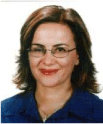The 2020 İzmir earthquake and its effect on COVID-19 cases
Seyfi Durmaz A * , Gönül Aslan B , Raika Durusoy C and Candan Çiçek DA
B
C
D

Seyfi Durmaz is an Associate Professor of Public Health and worked in the Occupational Health and Safety Unit at Ege University Hospital during the pandemic period, actively tracking COVID-19 cases and high-risk contacts among healthcare workers. His research interests include health policy, tobacco control, infectious disease surveillance, occupational health, and medical education. |

Dr Gönül Aslan is a Professor of Microbiology and the Head of the Department at Mersin University Faculty of Medicine. Her areas of interest include tuberculosis and immunology, and she has also served as the regional coordinator for COVID-19 diagnosis. |

Raika Durusoy is a Professor of Public Health at Ege University, and she is the surveillance officer of the university hospital and responsible for the hospital’s occupational health and safety unit, which actively continues to follow up on COVID-19 cases and contacts among the hospital staff since the beginning of the pandemic. Her research interests are communicable disease surveillance, tobacco control and environmental health. |

Candan Çiçek is a Professor of Microbiology and an infectious diseases and clinical microbiology specialist with 30 years of experience in Ege University Medical School at the Department of Clinical Microbiology. Her academic and research interests include diagnostic microbiology, virology and healthcare-related infections. She is currently the President of the Turkish Society for Microbiology. |
Abstract
On 30 October 2020, an earthquake measuring 6.9 moment magnitude occurred between Kusadasi and Samos, Türkiye, with a significant impact on buildings in the Bornova–Bayraklı district of İzmir. Immediately afterwards, a comprehensive study was commenced to investigate the relationship between the earthquake that occurred during the SARS-CoV-2 (COVID-19) pandemic and case numbers at the Ege University, Faculty of Medicine’s Hospital in Bornova, İzmir. This cross-sectional study was carried out based on the records of those admitted to the university hospital with suspicion of COVID-19 in the pre-earthquake and post-earthquake periods of the pandemic. The microbiology laboratory of the hospital used reverse transcription–polymerase chain reaction (RT-PCR) results as a dependent variable and compared with the time, age and gender as the independent variables, classified according to the timing of the earthquake. RT-PCR test results were positive in 11.60% of the whole study group; however, tests were 6.69% positive before the earthquake and increased to 23.42% afterwards (P < 0.001), which equated to an increase of 4.25 times (95% CI 4.04–4.47) when comparing pre- to post-earthquake RT-PCR positivity (P < 0.001). The positive COVID-19 RT-PCR detection rate among those aged 50 and over was greater by a factor of 1.15 (95% CI 1.06–1.23) compared to a younger age group (P < 0.001). There was no difference for the gender variable used in suspected case or contact tracing applications of COVID-19 PCR. However, when stratified by age and gender, in the female group, there was a 1.24-fold (95% CI 1.11–1.38) increase in the 50+ age group (26.2%) compared to the younger age group (22.2%) after the earthquake (P < 0.001). In the male group, the rate of laboratory diagnosis of COVID-19 before the earthquake was in the under-50 age group (7.6%) as compared to the >50 age group (5.2%; P < 0.001).
Keywords: age, COVID-19, earthquake, epidemic curve, epidemiology, gender, İzmir, SARS-CoV-2, Türkiye.
Introduction
In Türkiye, most of the 60% of the population live in built-up areas where significant number of structures are vulnerable to earthquakes.1 On 30 October 2020, an earthquake of 6.9 moment magnitude (Mw) occurred in the Aegean Sea, epicentre at Seferihisar, Türkiye. The earthquake caused extensive damage in İzmir; Türkiye’s third largest city located ~70 km from the epicentre with a population of over 4.5 million. Damage was concentrated in Bornova and Bayraklı districts of İzmir, where the ground was soft and alluvial. The earthquake killed 117 people and injured more than 1000 others.2
The earthquake, which occurred during the SARS-CoV-2 2019 (COVID-19) pandemic, displaced more than 15 000 people. Most of these people were inhabitants of buildings that collapsed. Others forced to leave their homes after the earthquake also moved to temporary shelters. Temporary shelters were set up at various locations in İzmir. These shelters consisted of containers, tents, and other temporary structures.3 The number of people involved in rescue operations reached significant numbers and this led to population mobilisation subsequently increasing the risk of human-to-human contact. Simultaneously, the COVID-19 pandemic had a significant human and economic impact worldwide, including İzmir. The confluence of the earthquake and pandemic in İzmir may have increased vulnerability to infection due to the inability to maintain physical distancing and to comply with safety regulations, such as a lack of protective equipment.3
The Governor of İzmir, Mr Köşger, in a report published by the İzmir Medical Chamber, stated that all COVID-19 positive cases and their contacts ran out to the streets when the earthquake struck, encountering others. In the report, it was stated that COVID-19 positive cases and virus-related deaths thus increased 3-fold after the earthquake.4
The 2020 İzmir Earthquake was a major natural disaster during the COVID-19 pandemic. The earthquake caused significant damage and displacement and likely contributed to the spread of COVID-19. Thus, a need rose to investigate the relationship between the earthquake and the increase in COVID-19 cases and deaths in İzmir. This study, conducted at Ege University, Faculty of Medicine’s Hospital in İzmir, aimed to examine whether there was a relationship between the earthquake during the pandemic and the rise in COVID-19 cases in the Ege University, Faculty of Medicine’s Hospital in İzmir.
Methods
The Hospital started registering and testing all patients admitted with suspected COVID-19 as of 23 March 2020. Nasopharyngeal swabs of the applicants were taken in safe cabinets in outpatient clinics or wards where they were admitted and sent to the virology laboratory in viral nucleic acid buffer (Bio-Speedy vNAT Viral Nucleic Acid Buffer, Bioeksen, İstanbul, Türkiye). COVID-19 reverse transcription–polymerase chain reaction (RT-PCR) tests detected the causative agent in samples that were then sent to Ege University Medical Microbiology Laboratory. The tests used were approved by the Turkish Ministry of Health (Bio-Speedy SARS-CoV-2, Bioeksen; Diagnovital SARS-CoV-2 RT-PCR, RTA; and Coronex RT-qPCR, Gensutek, Türkiye). All amplification procedures and analyses were performed with Rotorgene (Qiagene, Luxembourg).
In this cross-sectional study, a case–time graph was created using the data from the positive test results reported in the Hospital’s Microbiology Laboratory (Fig. 1, start time of the laboratory tests, 30 October 2020, v. the end of the peak of the pandemic, 21 December 2020). All data containing RT-PCR results up to the last date shown on the graph were included in this study (except for dates between 31 October and 1 November, as explained below). The Ministry of Health recommends testing for RT-PCR positivity for COVID-19 from the third day after contact.5,6 Therefore, considering the date of the earthquake, data from 31 October to 1 November 2020 were excluded from the study.
The data between 23 March 2020, when the testing started in the laboratory, and 30 October 2020, when the earthquake occurred, were classified as ‘pre-earthquake’. The period from the third day of the earthquake until 21 December 2020, when the peak in the graph ended, was considered ‘post-earthquake’. The age parameter was used as a measurement variable and categorised (as <50 and ≥50). The gender parameter was used as the categorical variable.
Statistical analyses were performed using SPSS statistical software for Windows (ver. 25.0, SPSS, Chicago, IL, USA). The data were visualised using Excel 2016 (ver. 16.0.4266.1001, Microsoft Online) and S/R programming. The results are presented as numbers (n), frequencies (%), means and standard deviations. The Shapiro–Wilk test was used to test the normality of the age data. The difference between two independent samples was analysed using an independent two-sample t-test for samples drawn from normally distributed populations. The Chi-Square test was used to examine whether there was a statistically significant relationship (difference) between the two categorical variables. Logistic regression was used for odds ratio (OR) calculation of variables that were found to be associated with positive RT-PCR results – a P-value ≤ 0.05 was considered significant for statistical tests.
Results
Between 23 March and 21 December 2020, 62 550 people were admitted to the Hospital with suspected COVID-19. From the data registered, 44 072 (70.7%) were admitted during the pre-earthquake period, and 18 263 (29.3%) were admitted during the post-earthquake period. After the earthquake, the number of cases reached its highest level (n = 188) in mid-November 2020 and completed its cycle (7 weeks) towards the end of December (n = 215, 0.3%) of the laboratory results from 2 days immediately after the earthquake were excluded from the study as described earlier).
The mean age of the individuals was 41.18 ± 20.92, and 50.6% were male. The mean age of the applicants was 41.76 ± 21.64 years before the earthquake and 39.72 ± 18.96 years after the earthquake (P < 0.001). There was no statistically significant difference between the genders (P = 0.469). PCR positivity was 11.60% for all laboratory results. Although this rate was 6.69% before the earthquake, it was 23.42% after it (P < 0.001) (Table 1).
| Pre-earthquake (n = 44 072; 70.70%) | Post-earthquake (n = 18 263; 29.30%) | Total (n = 62 335; 100%) | |||||||
|---|---|---|---|---|---|---|---|---|---|
| n | % | n | % | P | n | % | |||
| RT-PCR | Negative | 41 123 | 93.31 | 13 986 | 76.58 | <0.001 | 55 109 | 88.40 | |
| Positive | 2949 | 6.69 | 4277 | 23.42 | 7226 | 11.60 | |||
| Gender | Female | 21 735 | 49.32 | 9065 | 49.64 | 0.469 | 30 800 | 49.41 | |
| Male | 22 337 | 50.68 | 9198 | 50.36 | 31 535 | 50.59 | |||
| Age | <50 | 28 601 | 64.90 | 13 142 | 71.96 | <0.001 | 41 743 | 66.97 | |
| ≥50 | 15 471 | 35.10 | 5121 | 28.04 | 20 592 | 33.03 | |||
| Mean | s.d. | Mean | s.d. | P | Mean | s.d. | |||
| Age | 41.76 | 21.64 | 39.72 | 18.96 | <0.001 | 41.18 | 20.92 | ||
As seen in Table 2, the positivity of RT-PCR tests increased by 4.25 (95% CI 4.04–4.49) in those COVID-19 suspected cases after the earthquake compared to those who applied before the earthquake (P < 0.001). While there was no significant relationship between RT-PCR positive detection and gender, the significant association with age lost its significance in gender- and age-adjusted analyses (P = 0.151).
| 95% CI for OR | P | Adjusted | 95% CI for Adj. OR | P | ||||||||
|---|---|---|---|---|---|---|---|---|---|---|---|---|
| n | % | OR | Lower | Upper | OR | Lower | Upper | |||||
| Earthquake | Post-eathquake | 4277 | 23.42 | 4.26 | 4.05 | 4.49 | <0.001 | 4.25 | 4.04 | 4.47 | <0.001 | |
| Pre-eathquake | 2949 | 6.69 | 1 | 1 | ||||||||
| Gender | Male | 3677 | 11.62 | 1.01 | 0.96 | 1.06 | 0.758 | |||||
| Female | 3566 | 11.54 | 1 | |||||||||
| Age | ≥50 | 2189 | 10.58 | 0.86 | 0.82 | 0.91 | <0.001 | 0.96 | 0.91 | 1.02 | 0.151 | |
| <50 | 5054 | 11.58 | 1 | 1 | ||||||||
As seen in Table 3, in the pre-earthquake period, the rate of RT-PCR positive detection, which was 7.2% in the group under 50 years of age, was 5.8% in the group aged 50 years and older. In the older age group, RT-PCR positivity was 20.9% (95% CI 14.2–17.1) lower than that in the younger age group (P < 0.001). Post-earthquake, the RT-PCR positivity rate increased in both age groups and was 25.2% in the group aged ≥50 years and 22.7% in the group aged <50 years. Thus, the RT-PCR positive detection rate in the group aged 50 years and over was 1.15 times (95% CI 1.06–1.23) greater than the detection rate in the lower age group (P < 0.001).
| 95% CI for EXP(B) | P | ||||||||
|---|---|---|---|---|---|---|---|---|---|
| n | % | OR | Lower | Upper | |||||
| Total | Pre-earthquake | ≥50 | 893 | 5.8 | 0.79 | 0.73 | 0.86 | <0.001 | |
| <50 | 2056 | 7.2 | |||||||
| Post-earthquake | ≥50 | 1290 | 25.2 | 1.15 | 1.06 | 1.23 | <0.001 | ||
| <50 | 2987 | 22.7 | |||||||
| Female | Pre-earthquake | ≥50 | 455 | 6.4 | 0.93 | 0.83 | 1.05 | 0.239 | |
| <50 | 996 | 6.8 | |||||||
| Post-earthquake | ≥50 | 618 | 26.2 | 1.24 | 1.11 | 1.38 | <0.001 | ||
| <50 | 1491 | 22.2 | |||||||
| Male | Pre-earthquake | ≥50 | 438 | 5.2 | 0.67 | 0.60 | 0.76 | <0.001 | |
| <50 | 1060 | 7.6 | |||||||
| Post-earthquake | ≥50 | 672 | 24.3 | 1.06 | 0.96 | 1.18 | 0.255 | ||
| <50 | 1496 | 23.2 | |||||||
In the female group, although there was no significant difference between the older age group (6.4%) and the younger group (6.8%) before the earthquake (P = 0.239), after the earthquake there was a 1.24-fold (95% CI 1.11–1.38) increase in the 50 years and older age group (26.2%) compared to the younger group (22.2%; P < 0.001).
In the male group, although there was a difference in the group under 50 years of age before the earthquake, the PCR positivity rate increased after the earthquake, and the difference between age groups disappeared. In the male group, the rate of COVID-19 diagnosis in the laboratory before the earthquake was 32.5% (95% CI 24.3–39.8) less in the over 50 years age group (5.2%) than in the under 50 years age group (7.6%; P < 0.001). After the earthquake, the rate was 24.3% in the group aged ≥50 years and 23.2% in the group aged <50 years, and there was no significant difference (P = 0.255) between the age groups.
Discussion
This study examined the temporal relationship between the earthquake of 30 October 2020, and the increase in COVID-19 cases in the hospital. No association was found between gender and the rise in COVID-19 cases before and after the earthquake. However, when evaluated according to age, COVID-19 cases before the earthquake were higher in the group under the 50 years of age.
It was observed that COVID-19 cases detected in İzmir increased more than four times in the peak period after the earthquake compared to the pre-earthquake period. Studies conducted in the past have revealed a significant increase in respiratory tract infections (RTIs) following earthquakes.7,8 RTIs resulting from earthquakes can manifest as acute and chronic consequences of natural disasters. During the immediate aftermath of an earthquake, RTIs may arise as a result of inhaling tiny particles, smoke or other harmful fumes, as well as from ingesting water-based pathogens, chest injuries, living nearby in overpopulated makeshift camps or shelters over the extended course, and certain psychological impacts that can lead to weakened immunity.8 Overcrowded environments resulting from unplanned and crowded shelters after earthquake disasters, inadequate access to clean drinking or utility water, and malnutrition caused by limited transport leading to food shortages in the region can encourage the transmission of infectious agents among people. Such conditions increase the chance of common viral respiratory diseases in people living in proximity.8
After the earthquake of October 2020, due to the cold weather in November and December, people whose houses were destroyed or damaged were urgently placed in shelters. People aged over 50 who were not working at that time due to the pandemic had to come out of home isolation and were kept together under unfavourable conditions in crowded environments. This earthquake, which coincided with the 10th month of the COVID-19 pandemic, caused the COVID-19 cases to increase more than 4-fold. The Turkish Medical Association’s first monthly report on the İzmir earthquake stated that there had been a significant increase in COVID-19 cases in the country.9
In studies conducted before the pandemic, increases in the incidence of acute respiratory infections were also reported after the 2005 Pakistan earthquake; as for the 2001 El Salvador earthquake, 30% of 594 affected people were reported to have RTIs. In Iran, 14% of 75 586 people who lost their homes due to the Bam earthquake 2003 were found to have RTIs.8
Since the beginning of the pandemic, young adult males were most frequently infected with COVID-19 in our region, while, after the earthquake, women aged over 50 were most often infected. In addition to coming out of home isolation prematurely, men and women aged over 50 also took part in the field to help their families and environment, regardless of gender. After the İzmir earthquake, many people from both domestic and foreign regions came to help, and the profile definition of people who were positive before the earthquake changed with the earthquake.4 Balbay et al. (2011) analysed tuberculosis patients’ demographic and socioeconomic characteristics in three periods before, during and after the Düzce earthquake.10 The mean age of the patients was found to be significantly higher in the pre-earthquake period (50.50 ± 18.05) than in the earthquake period (36.26 ± 13.77) and post-earthquake period (41.34 ± 17.22). No significant difference was found between the groups in terms of gender.10
Conclusion
The highest number of cases in Türkiye since the beginning of the pandemic was recorded in early December 2020, which was ~1 month after the earthquake. The effect of the earthquake on these cases was thus investigated and results revealed a 4-fold increase after the earthquake. In addition, people aged over 50 who were in isolation before the earthquake had to break isolation prematurely and be exposed to earthquake-affected zones due to the loss of their homes as well as participating in post-earthquake relief activities. For this reason, the slight predominance of COVID-19 positivity among young men before the earthquake shifted to a post-earthquake predominance of positivity in people aged over 50, with a slightly greater positivity rate in older women.
Acknowledgements
We thank everyone who contributed to the study presented here, including healthcare professionals in medical microbiology laboratory, infectious diseases, chest diseases, pediatric and adult emergency clinics, and occupational health and safety units.
References
1 National Earthquake Council (2005) Türkđye Ulusal Deprem Aratirmalari Programi (TUDAP) 2005–2014. [Türkiye National Earthquake Research Programme (TUDAP) 2005–2014.] www.tubitak.gov.tr/tubitak_content_files/ARDEB/kamag/Turkiye_Ulusal_Deprem_Arastirmalari_Programi.pdf (in Turkish, accessed 8 September 2023)
2 Demirci HE et al. (2021) A survey of damage observed in İzmir due to 2020 Samos-İzmir earthquake. Nat Hazards 111, 1047-1064.
| Crossref | Google Scholar |
3 Dünya Doktorları Derneği (2020) İzmir earthquake rapid assessment report. November 2020. https://www.dunyadoktorlari.org.tr/media/pages/medya/yayinlar/izmir-earthquake-rapid-assessment-report-november-2020/dadb5d58d9-1631865649/ddd-izmir-earthquake-assessment-report.pdf (accessed 29 September 2023)
4 İzmir Medical Chamber (2020) İzmir Depremi Birinci Ay Değerlendirme Raporu. [İzmir earthquake rapid assessment report.] In İzmir Tabip Odası, 8 December 2020. https://www.izmirtabip.org.tr/news/4832 (in Turkish, accessed 8 September 2023)
5 Republic of Türkiye’s Ministry of Health (2020) Contact tracking, epidemic management, patient monitoring at home and filiation. https://covid19.saglik.gov.tr/TR-66339/temasli-takibi-salgin-yonetimi-evde-hasta-izlemi-ve-filyasyon.html (accessed 29 September 2023)
6 Uçar A et al. (2020) An interactive and real-time web application for monitoring of COVID-19 pandemic in Türkiye: TURCOVID19. Anadolu Clin 25, 154-155.
| Crossref | Google Scholar |
7 Robinson B et al. (2011) Natural disasters and the lung. Respirology 16, 386-395.
| Crossref | Google Scholar |
8 Kouadio IK et al. (2012) Infectious diseases following natural disasters: prevention and control measures. Expert Rev Anti Infect Ther 10, 95-104.
| Crossref | Google Scholar | PubMed |
9 Turkish Medical Association (2020) İzmir earthquake first month preliminary evaluation report, 01.12.2020. https://www.ttb.org.tr/905yic0 (in Turkish, accessed 1 September 2023)
10 Balbay Ö et al. (2011) The effects of two sequential earthquakes on tuberculosis patients: an experience from Düzce earthquake. HealthMED 5, 589-595.
| Google Scholar |
 Seyfi Durmaz is an Associate Professor of Public Health and worked in the Occupational Health and Safety Unit at Ege University Hospital during the pandemic period, actively tracking COVID-19 cases and high-risk contacts among healthcare workers. His research interests include health policy, tobacco control, infectious disease surveillance, occupational health, and medical education. |
 Dr Gönül Aslan is a Professor of Microbiology and the Head of the Department at Mersin University Faculty of Medicine. Her areas of interest include tuberculosis and immunology, and she has also served as the regional coordinator for COVID-19 diagnosis. |
 Raika Durusoy is a Professor of Public Health at Ege University, and she is the surveillance officer of the university hospital and responsible for the hospital’s occupational health and safety unit, which actively continues to follow up on COVID-19 cases and contacts among the hospital staff since the beginning of the pandemic. Her research interests are communicable disease surveillance, tobacco control and environmental health. |
 Candan Çiçek is a Professor of Microbiology and an infectious diseases and clinical microbiology specialist with 30 years of experience in Ege University Medical School at the Department of Clinical Microbiology. Her academic and research interests include diagnostic microbiology, virology and healthcare-related infections. She is currently the President of the Turkish Society for Microbiology. |



